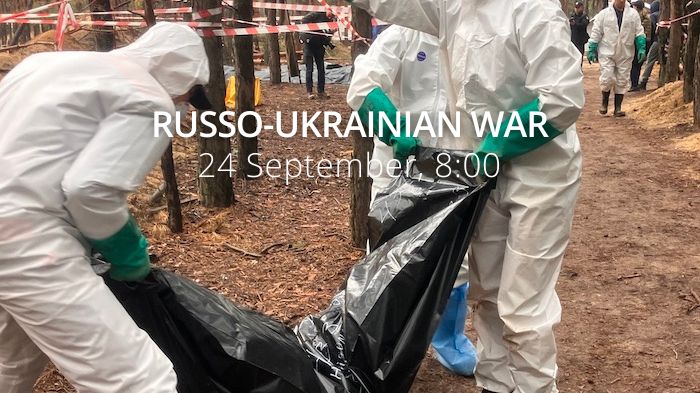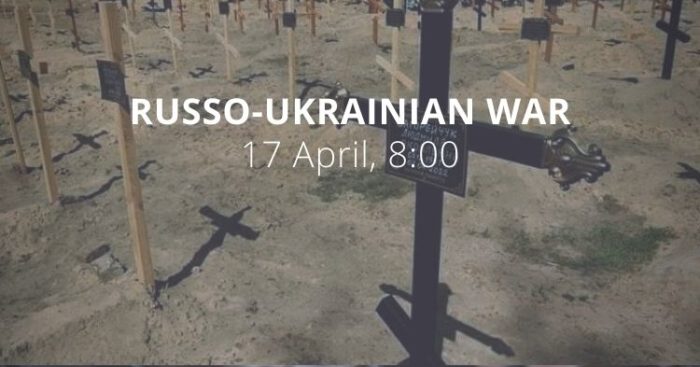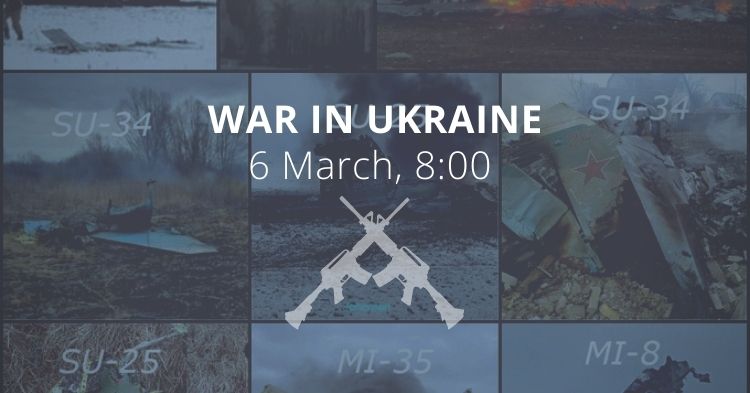Russian partial mobilization efforts are suffering from serious and systemic problems in their first days. Protests, attacks against recruiting centers, and vandalism reported across Russia in the first 48 hours after the announcement of partial mobilization. Ukrainian forces continued to advance north and northwest of Lyman. Ukrainian forces continued their interdiction campaign in Kherson Oblast and maintained operational silence regarding this front. Russian forces continued to launch unsuccessful assaults near Bakhmut and northwest of Donetsk City. Iranian drones reported over the Dnipro and Odesa. In the occupied territories, pseudo-referendums are held at gunpoint. The exhumation of 447 bodies from the mass grave in Izium, Kharkiv Oblast, is completed.
Daily overview — Summary report, September 24
A map of the approximate situation on the ground in Ukraine as of 00:00 24/09/22.
There have been no notable changes to control since the last update. pic.twitter.com/7NaNaWkKPF
— War Mapper (@War_Mapper) September 24, 2022
The General Staff’s operational update regarding the Russian invasion as of 06.00 am, September 24, 2022 is in the dropdown menu below.

https://www.facebook.com/GeneralStaff.ua

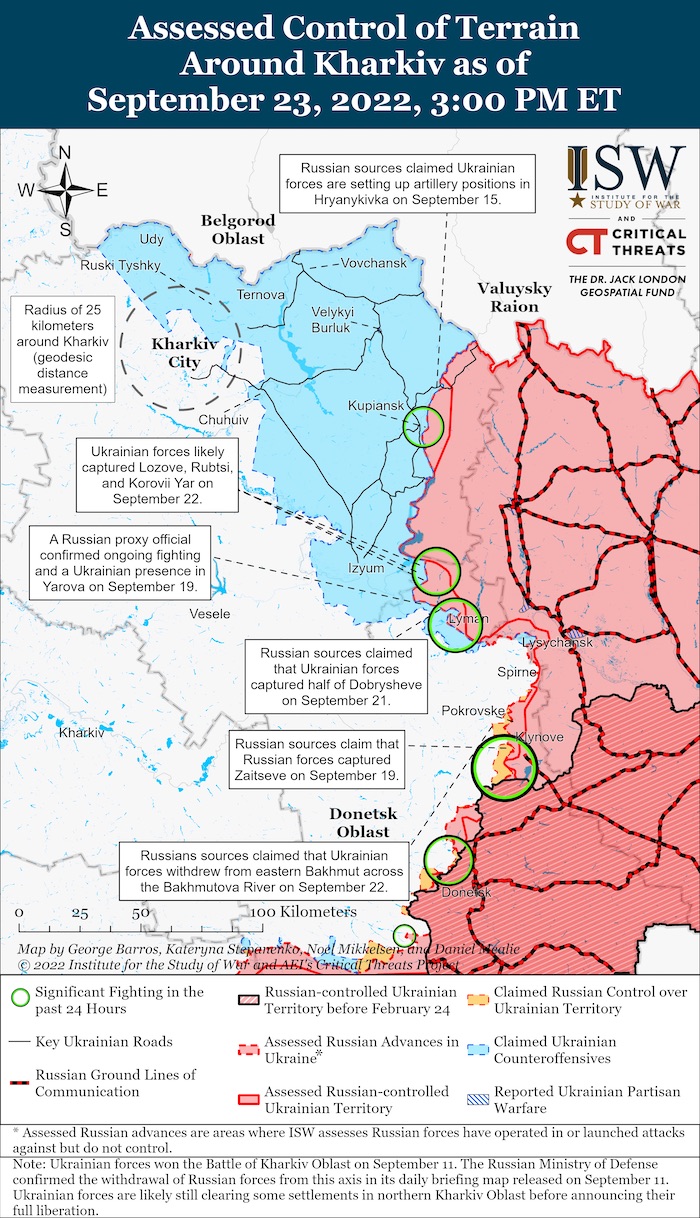
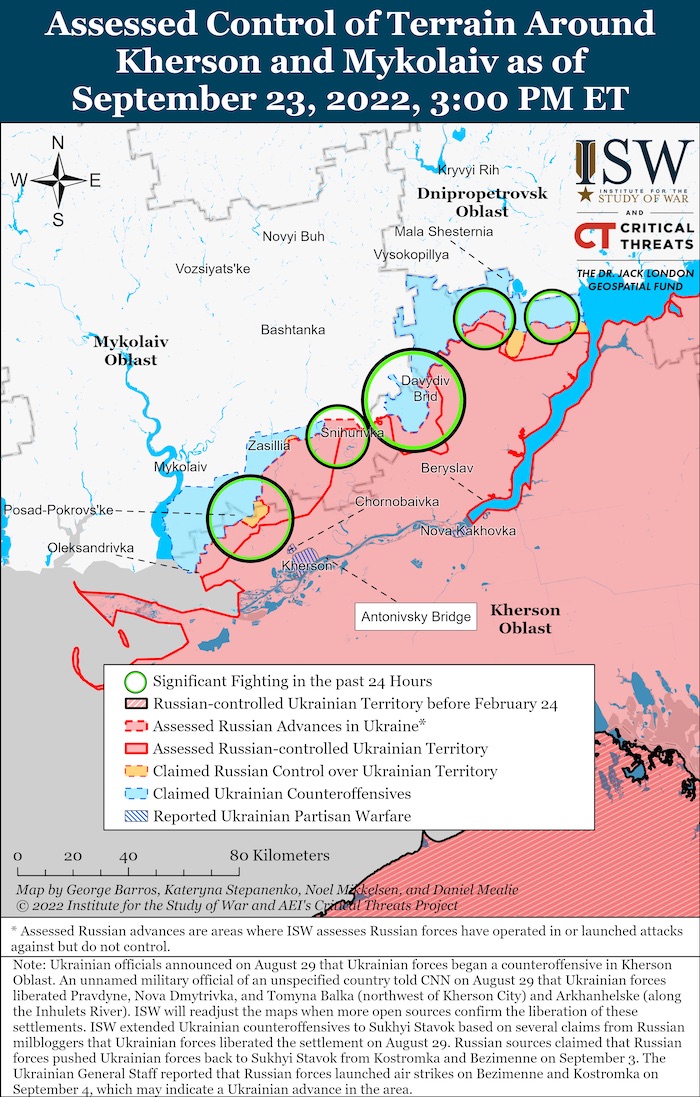
Military Updates
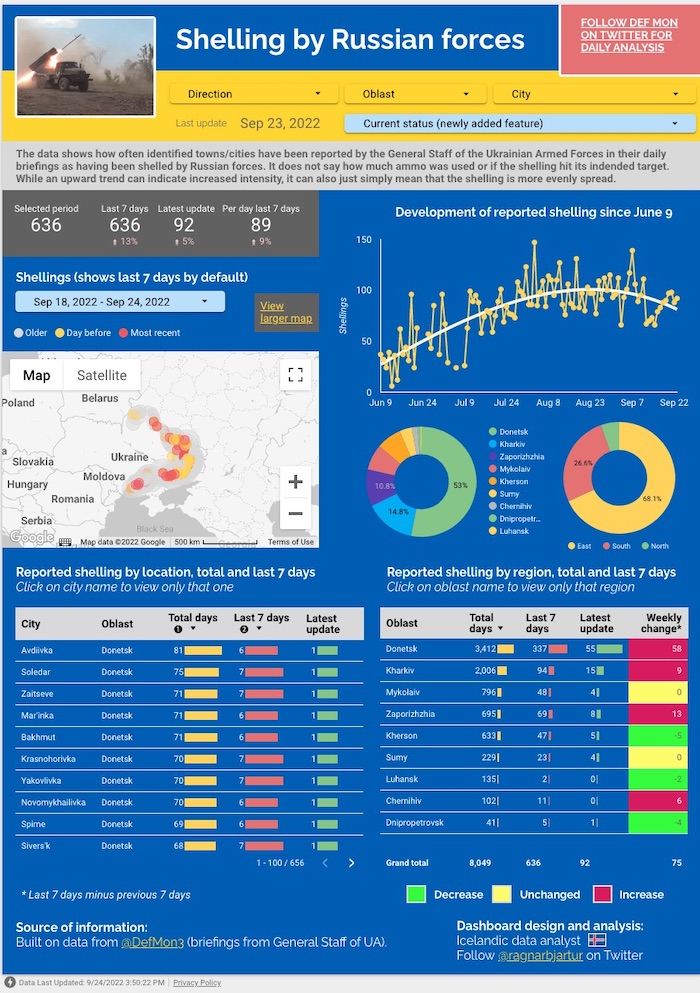
Regional Updates
Ukraine liberates one more village in Donetsk Oblast, improves positions near Bakhmut - GenStaff
According to a representative of Ukraine's General Staff, Ukraine has liberated Yatskivka village in Donetsk Oblasthttps://t.co/7N2kptQZOt pic.twitter.com/52Be5T5Wy4
— Euromaidan Press (@EuromaidanPress) September 23, 2022
In the Donetsk Oblast, the Ukrainian military liberated the village of Yatskovka in the Donetsk region and restored previously lost positions south of Bakhmut, as announced by the Deputy Chief of the Main Operational Directorate of the General Staff of the Armed Forces of Ukraine Oleksiy Gromov.
In the Luhansk Oblast, the Ukrainian army is preparing
to liberate settlements in the Lyman direction, according to the adviser of the Eastern Group of Forces of the Armed Forces of Ukraine Serhiy Cherevaty. “Our headquarters know the details... they clearly carry out the tasks assigned to them. The enemy does not need to know too many details, and our population will soon find out,” Cherevaty said. After the liberation of Kupiansk, Lyman is the next step towards the liberation of the Luhansk Oblast. "And, of course, this will be done at a certain time. Each settlement is important for us, and [Lyman], including from the operational-tactical point of view."
https://twitter.com/EuromaidanPress/status/1573351704686362625
In the Kharkiv Oblast, in Izium, Russian troops left behind more than one mass grave with the corpses of civilians. the law enforcement officers completed the exhumation of 447 bodies from the mass grave in Izium, Kharkiv Oblast. Many bodies show signs of violent death, torture. 425 civilians, 5 children, 22 servicemen.
https://twitter.com/EuromaidanPress/status/1573400548245929985
In the Dnipropetrovsk Oblast, 2 Iranian Shahid-136 UAVs reported in the Dnieper, some intercepted and eliminated.
In the Zaporizhzhia Oblast, a civilian infrastructure facility destroyed, houses and cars around damaged. 3 hospitalized with minor injuries. Also, one rocket hit a construction site near the city in the Zaporizhzhia Oblast. No casualties reported.
https://twitter.com/EuromaidanPress/status/1573251828686508032
Russia plans to form an independent state on the territory of the occupied part of Zaporizhzhia Oblast
Then, according to member of so-called Main Council of the Administration of the Zaporizhzhia Region Vladimir Rogov, it will join Russia, TASS reportedhttps://t.co/eHcrpBBiTF
— Euromaidan Press (@EuromaidanPress) September 23, 2022
Sociologists estimate how southeastern Ukraine would vote in a real referendum on joining Russia
They used a regression model and multiple polls of pro-Russian secession sentiments in the region https://t.co/Wq9wnrIA96
— Euromaidan Press (@EuromaidanPress) September 23, 2022
In the Mykolaiv Oblast, 35 private houses, 6 high-rise buildings and two stores damaged. The explosion damaged the city's water supply. The repair team has been working on site. Residents of the occupied Snihirevka, Mykolaiv region, rallied against the "referendum."
https://twitter.com/EuromaidanPress/status/1573321476714938368
In the Odesa Oblast, Odesa was attacked by Iranian kamikaze drones from the sea, 1 civilian dead. An administrative building destroyed in the port area, and rescue services are fighting the fire. One "Shahid-136" was shot down over the sea by air defense forces.
Odesa waits to join UNESCO list while grappling with monument to Russian Empress Catherine II
According to British Defence Intelligence, (last 48 hours):
https://twitter.com/DefenceHQ/status/1573336327730372609
- On 21 and 22 September 2022, Russia struck the Pechenihy dam on the Siverskyy Donets River using short range ballistic missiles or similar weapons. This follows a strike on the Karachunivske Dam near Krivyy Rih in central Ukraine on 15 September 2022.
- Ukrainian forces are advancing further downstream along both rivers. As Russian commanders become increasingly concerned about their operational set-backs, they are probably attempting to strike the sluice gates of dams, in order to flood Ukrainian military crossing points.
- The attacks are unlikely to have caused significant disruption to Ukrainian operations due to the distance between the damaged dams and the combat zones.
Losses of the Russian army
As of 24 September, the approximate losses of weapons and military equipment of the Russian Armed Forces from the beginning of the war to the present day:
These are the indicative estimates of Russia’s combat losses as of Sept. 23, according to the Armed Forces of Ukraine. pic.twitter.com/lvnL5CT9tp
— The Kyiv Independent (@KyivIndependent) September 23, 2022
Humanitarian
Environmental
Legal
https://twitter.com/EuromaidanPress/status/1573416923957633025
Fake referendums are held in the occupied territories of Donetsk, Luhansk, Kherson and Zaporizhzhia Oblasts. People are driven to the polling stations by force, seized at home and in the street. if the results of the expression of will.
Support
G7 condemn Russia's pseudo-referenda show in Ukraine, pledge more sanctions
Any annexation of Ukrainian territory would be a gross violation of Ukraine’s sovereignty and the UN Charter," the statement said https://t.co/rKAM4ybFve
— Euromaidan Press (@EuromaidanPress) September 23, 2022
New Developments
Hungary wants "peace," its foreign minister tells Lavrov, condemning EU sanctions
Szijjarto was the only EU foreign minister to talk to Lavrov in New York hours after EU Commission spox told reporters it doesn't make sense to talk to Russiahttps://t.co/riTh0uyf2B pic.twitter.com/wn4MoiKVv2
— Euromaidan Press (@EuromaidanPress) September 23, 2022
Finland to 'significantly restrict' border crossings from Russia amid mobilization for the war in Ukraine
The decision is needed to prevent serious damage to Finland’s international position, the Finnish government said https://t.co/Qu2bTSZmc3
— Euromaidan Press (@EuromaidanPress) September 23, 2022
Assessment
- On the war.
The Institute for the Study of War has made the following assessment as of 23 September, 2022:
The Russian mobilization system is struggling to execute the task Russian President Vladimir Putin set and will likely fail to produce mobilized reserve forces even of the low quality that Putin’s plans would have generated unless the Kremlin can rapidly fix fundamental and systemic problems. Putin and Defense Minister Sergey Shoigu announced that the Russian Armed Forces would mobilize combat-ready reservists to quickly stabilize the frontlines and regain the initiative on the battlefield.[1] Milblogger and social media reports, however, show that Russian military recruitment centers, enlistment officials, and local administrations are mobilizing men who do not meet the Kremlin’s stated criteria, especially Shoigu’s promise that mobilization would prioritize men with “combat experience.” Russian opposition outlets and Telegram channels leaked information suggesting that the Kremlin aims to complete this partial mobilization by November 10 and that the Kremlin is seeking to mobilize 1.2 million men instead of the publicly announced 300,000.[2] ISW cannot verify these reports, but significant available information suggests that this mobilization campaign (the first in post-Soviet Russia) is overwhelming an ineffective and unmotivated bureaucratic system and could fail to generate the much-needed combat-ready reserve force in a short time or at all.
Russian pro-war milbloggers and social media users are raising concerns about unlawful mobilization practices and showcasing many serious Russian mobilization problems on the second day of the mobilization effort. Russian milbloggers reported receiving numerous complaints from social media users that older men, students, employees of military industries, and civilians with no prior military experience are receiving illegal mobilization notices.[3] Shoigu and other officials have repeatedly stated that these categories of individuals would be exempt from this partial mobilization. Other sources reported that Russians are mobilizing airport and airline employees and workers from other industries.[4] The Russian government FAQ portal also indicated that local mobilization-enforcing officials may mobilize part-time students, despite the Kremlin’s declaration that no students will undergo mobilization.[5]
Some milbloggers noted that Russian enlistment personnel are assigning men with prior military service to very different specializations from those in which they served, while other sources recounted instances of military recruitment centers mobilizing men with chronic illnesses.[6]
The quality of Russian bureaucrats and military trainers are also raising fears among the Russian pro-war crowd that the partial mobilization effort may not succeed. Milbloggers noted that employees of the military enlistment centers are unmotivated and underpaid, reducing their enthusiasm to adhere to the envisioned mobilization plan. Milbloggers also pleaded with officers and commanders in charge of preparing mobilized men for war to train them before deployment.[7]
Challenges and errors in the first days of executing a large-scale and demanding partial mobilization in the midst of a failing war are not necessarily surprising, although they suggest that the Russian military mobilization infrastructure was not better prepared for a major war than the Russian armed forces themselves. It is nevertheless conceivable that the Russian Ministry of Defense will address some of the worst problems and get the mobilization effort on track. It is also possible, moreover, that much of the partial mobilization is proceeding more or less as planned and that social media and the milblogger community are highlighting problems that are serious but not necessarily pervasive. Some of the reports suggest, however, that regional mobilization officials have been given quotas to fill and received pressure to fill them in ways that are more likely to cause errors than to reward adherence to the stated principles and the needs of an effective, combat-ready reserve force.
Divergences from the mobilization decree and from Putin’s and Shoigu’s statements about the categories of men who are exempt from mobilization are also causing anger and mistrust toward Russian federal subjects and the Kremlin itself. Some social media footage already shows mobilized men fighting with enlistment officers, arguing with mobilization representatives, and refusing to serve under unlawful orders.[8] Some milbloggers claimed that some of the discontented men who have been wrongfully mobilized would have accepted their fate if they had actually met the mobilization criterium.[9] The Kremlin is thus committing unmotivated and potentially angry men to war with the task of regaining the initiative in an offensive war in a foreign land on a battlefield far from home.
The highly nationalist and pro-war milblogger community is calling on the Kremlin to address these mobilization issues rapidly, but the Kremlin is unlikely to be able to meet their demands. Russian milbloggers express cautious optimism that partial mobilization will reinforce degraded combat units and allow Russian forces to advance in Donetsk Oblast, but are concerned that the Kremlin’s failures to enforce mobilization according to the law and stated policies will create political unrest.[10] One milblogger stated that the Kremlin’s poor handling of the partial mobilization is giving rise to “separatist movements” and opposition media.[11] Another milblogger noted that the Kremlin’s failure to fix mobilization practices within the military recruitment centers may shatter Russians‘ trust in the military-political leadership.[12] A failed or badly flawed partial mobilization campaign may risk further alienation of the Russian nationalist crowd that has been supportive of the war and mobilization.
Disparate mobilization processes across different regions may exacerbate social tensions in Russia already raised by perceived inequalities in the creation of volunteer battalions. Chechen leader Ramzan Kadyrov stated in a live TV broadcast that the Republic of Chechnya will not conduct mobilization because the Republic has already exceeded an unspecified force generation plan by 254 percent.[13] Kadyrov added that Chechnya has already deployed 20,000 servicemen to war since February 24. Kadyrov threatened to mobilize any protesters in Chechnya and send them to the front, however. Kadyrov then seemingly modified his statements by encouraging those opposing mobilization to respect Russian sovereignty instead of using the constitution to avoid service.[14] Kadyrov’s initial statement, addressed to the Chechen public, may be an attempt to both address and discourage criticism of mobilization, the war, and himself within the Chechen community. Kadyrov’s statement could also be a worrisome indicator for the Kremlin—if one of the war’s most vociferous and aggressive advocates feels the need to refuse to mobilize his people, at least publicly, that could indicate that even Kadyrov senses the popular resentment the partial mobilization will cause and possibly even fears it.
Key Takeaways
- Russian partial mobilization efforts are suffering from serious and systemic problems in their first days, generating popular resentment and setting conditions to produce a mobilized reserve force incapable of accomplishing the tasks Russian President Vladimir Putin has set for it.
- Protests, attacks against recruiting centers, and vandalism have occurred across Russia in the first 48 hours after the announcement of partial mobilization.
- Ukrainian forces continued to advance north and northwest of Lyman.
- Ukrainian forces continued their interdiction campaign in Kherson Oblast and maintained operational silence regarding Ukrainian progress on the axis.
- Russian forces continued to launch unsuccessful assaults near Bakhmut and northwest of Donetsk City.
- Ukrainian forces reportedly shot down an Iranian-made Mohajer-6 drone in an unspecified area of the Black Sea, likely near Odesa.
- Russian occupation authorities began the voting period for their sham annexation referenda on September 23 with overt coercion and falsified turnout numbers.
- Russian occupation authorities remained on high alert to prevent partisan attacks against sham election workers, polling stations, and government facilities.

